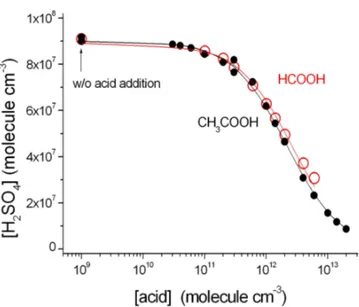Reactivity of stabilized Criegee intermediates (sCIs) from isoprene and monoterpene ozonolysis toward SO<sub>2</sub> and organic acids
Texto
Imagem

![Figure 1. Loss-corrected measured [H 2 SO 4 ] at the outflow of IfT- IfT-LFT in α-pinene experiments at RH = 10 % and RH = 50 %](https://thumb-eu.123doks.com/thumbv2/123dok_br/17149174.240025/5.918.80.446.104.358/figure-loss-corrected-measured-outflow-ift-pinene-experiments.webp)
![Table 2. Results according to Eqs. (3) and (4) from non-linear regression analysis [H 2 SO 4 ] = f([SO 2 ]).](https://thumb-eu.123doks.com/thumbv2/123dok_br/17149174.240025/7.918.135.779.132.291/table-results-according-eqs-non-linear-regression-analysis.webp)

Documentos relacionados
SOA formation from benzene, toluene, m -xylene, and their corresponding phenolic compounds were investi- gated using the UCR/CE-CERT Environmental Chamber to evaluate the importance
seems unlikely that SCI produced from isoprene ozonolysis alone are important for DMS oxidation, it is possible that (the sum of) SCI species produced from other alkene-
The experimental data obtained for the particle number concentration are pre- sented together with the simulated profile of 2,5-DHF (from the known initial concentrations and
Products of secondary organic aerosol (SOA) from aromatic volatile organic compounds (VOCs) – 2,3-dihydroxy-4-oxopentanoic acid, dicarboxylic acids, ni- tromonoaromatics,
Isoprene SOA concentrations increase as NO x emissions decrease (favoring the low-NO x pathway for isoprene oxidation), but decrease as SO 2 emissions decrease (due to the e ff ect
Heterotrophic microbes are the most important consumers of marine organic matter (OM), driving the microbial loop and MCP (Azam et al., 1983; Azam and Malfatti, 2007; Jiao et
Time series of wall-loss-corrected aerosol mass (right axis) and VOC consumed by each oxidant (left axis) for α -pinene and β - pinene at 0 (“O 3 -only”), low, and medium NO
We report first results obtained from chamber produced secondary organic aerosol (SOA) from ozonolysis of isoprenoids and from ambient aerosol as measured during the